CAMEO
Conflict and Mediation Event Observations
Event and Actor Codebook
Event Data Project
Department of Political Science
Pennsylvania State University
Pond Laboratory
University Park, PA 16802
http://eventdata.psu.edu/
Philip A. Schrodt (Project Director):
< schrodt@psu.edu >
(+1)814.863.8978
Version: 1.1b3
March 2012
�
Contents
1 Introduction
1.0.1 Events . . . . . . . . . . . . . . . . . . . . . . . . . . . . . . . . . . . . . . . .
1.0.2 Actors . . . . . . . . . . . . . . . . . . . . . . . . . . . . . . . . . . . . . . . .
1
1
4
2 VERB CODEBOOK
6
6
2.1 MAKE PUBLIC STATEMENT . . . . . . . . . . . . . . . . . . . . . . . . . . . . . .
2.2 APPEAL . . . . . . . . . . . . . . . . . . . . . . . . . . . . . . . . . . . . . . . . . .
9
2.3 EXPRESS INTENT TO COOPERATE . . . . . . . . . . . . . . . . . . . . . . . . . 18
2.4 CONSULT . . . . . . . . . . . . . . . . . . . . . . . . . . . . . . . . . . . . . . . . . 28
2.5 ENGAGE IN DIPLOMATIC COOPERATION . . . . . . . . . . . . . . . . . . . . . 31
2.6 ENGAGE IN MATERIAL COOPERATION . . . . . . . . . . . . . . . . . . . . . . 33
2.7 PROVIDE AID . . . . . . . . . . . . . . . . . . . . . . . . . . . . . . . . . . . . . . . 35
2.8 YIELD . . . . . . . . . . . . . . . . . . . . . . . . . . . . . . . . . . . . . . . . . . . . 37
2.9
INVESTIGATE . . . . . . . . . . . . . . . . . . . . . . . . . . . . . . . . . . . . . . . 43
2.10 DEMAND . . . . . . . . . . . . . . . . . . . . . . . . . . . . . . . . . . . . . . . . . . 45
2.11 DISAPPROVE . . . . . . . . . . . . . . . . . . . . . . . . . . . . . . . . . . . . . . . 52
2.12 REJECT . . . . . . . . . . . . . . . . . . . . . . . . . . . . . . . . . . . . . . . . . . 55
2.13 THREATEN . . . . . . . . . . . . . . . . . . . . . . . . . . . . . . . . . . . . . . . . 61
2.14 PROTEST . . . . . . . . . . . . . . . . . . . . . . . . . . . . . . . . . . . . . . . . . 66
2.15 EXHIBIT MILITARY POSTURE . . . . . . . . . . . . . . . . . . . . . . . . . . . . 73
2.16 REDUCE RELATIONS . . . . . . . . . . . . . . . . . . . . . . . . . . . . . . . . . . 74
2.17 COERCE . . . . . . . . . . . . . . . . . . . . . . . . . . . . . . . . . . . . . . . . . . 77
2.18 ASSAULT . . . . . . . . . . . . . . . . . . . . . . . . . . . . . . . . . . . . . . . . . . 80
2.19 FIGHT . . . . . . . . . . . . . . . . . . . . . . . . . . . . . . . . . . . . . . . . . . . 84
2.20 ENGAGE IN UNCONVENTIONAL MASS VIOLENCE . . . . . . . . . . . . . . . . 87
3 ACTOR CODEBOOK
89
3.1 HIERARCHICAL RULES OF CODING . . . . . . . . . . . . . . . . . . . . . . . . . 90
3.1.1 Domestic or International?
. . . . . . . . . . . . . . . . . . . . . . . . . . . . 91
3.1.2 Domestic Region . . . . . . . . . . . . . . . . . . . . . . . . . . . . . . . . . . 91
3.1.3 Primary Role Code . . . . . . . . . . . . . . . . . . . . . . . . . . . . . . . . . 91
3.1.4 Party or Speciality (Primary Role Code) . . . . . . . . . . . . . . . . . . . . . 94
3.1.5 Ethnicity and Religion . . . . . . . . . . . . . . . . . . . . . . . . . . . . . . . 94
Secondary Role Code (and/or Tertiary)
3.1.6
. . . . . . . . . . . . . . . . . . . . . 94
3.1.7
Specialty (Secondary Role Code) . . . . . . . . . . . . . . . . . . . . . . . . . 95
3.1.8 Organization Code . . . . . . . . . . . . . . . . . . . . . . . . . . . . . . . . . 95
3.1.9
. . . . . . . . . . . . . . . . . . . . . . . . . . . . . . . . 95
International Codes
i
�
CONTENTS
ii
3.2 OTHER RULES AND FORMATS . . . . . . . . . . . . . . . . . . . . . . . . . . . . 102
3.2.1 Date Restrictions . . . . . . . . . . . . . . . . . . . . . . . . . . . . . . . . . . 102
3.2.2 Actors and Agents . . . . . . . . . . . . . . . . . . . . . . . . . . . . . . . . . 102
3.2.3 Dictionaries . . . . . . . . . . . . . . . . . . . . . . . . . . . . . . . . . . . . . 103
3.2.4 Automatically-coded Celebrities
. . . . . . . . . . . . . . . . . . . . . . . . . 103
3.2.5 Coding Conventions . . . . . . . . . . . . . . . . . . . . . . . . . . . . . . . . 104
4 CAMEO Religious Coding Scheme
4.1
105
Introduction . . . . . . . . . . . . . . . . . . . . . . . . . . . . . . . . . . . . . . . . . 105
Self-Identification . . . . . . . . . . . . . . . . . . . . . . . . . . . . . . . . . . 105
4.1.1
Individualism . . . . . . . . . . . . . . . . . . . . . . . . . . . . . . . . . . . . 106
4.1.2
4.1.3 Hierarchies
. . . . . . . . . . . . . . . . . . . . . . . . . . . . . . . . . . . . . 106
4.2 First trio of letters . . . . . . . . . . . . . . . . . . . . . . . . . . . . . . . . . . . . . 106
4.3 Second trio of letters . . . . . . . . . . . . . . . . . . . . . . . . . . . . . . . . . . . . 107
4.3.1 Denominations . . . . . . . . . . . . . . . . . . . . . . . . . . . . . . . . . . . 107
4.3.2 Generic terms . . . . . . . . . . . . . . . . . . . . . . . . . . . . . . . . . . . . 107
4.3.3 Generic, or Denominational? . . . . . . . . . . . . . . . . . . . . . . . . . . . 108
4.3.4 Region . . . . . . . . . . . . . . . . . . . . . . . . . . . . . . . . . . . . . . . . 108
4.3.5 Nothing . . . . . . . . . . . . . . . . . . . . . . . . . . . . . . . . . . . . . . . 108
4.4 Third trio of characters
. . . . . . . . . . . . . . . . . . . . . . . . . . . . . . . . . . 108
4.5 Religion-specific coding issues . . . . . . . . . . . . . . . . . . . . . . . . . . . . . . . 109
4.5.1 Christianity . . . . . . . . . . . . . . . . . . . . . . . . . . . . . . . . . . . . . 109
4.5.2 Hinduism . . . . . . . . . . . . . . . . . . . . . . . . . . . . . . . . . . . . . . 109
Judaism . . . . . . . . . . . . . . . . . . . . . . . . . . . . . . . . . . . . . . . 109
4.5.3
4.5.4
Shintoism . . . . . . . . . . . . . . . . . . . . . . . . . . . . . . . . . . . . . . 110
5 CAMEO Ethnic Coding Scheme
111
Introduction . . . . . . . . . . . . . . . . . . . . . . . . . . . . . . . . . . . . . . . . . 111
5.1
5.2
Identification of Ethnic Groups . . . . . . . . . . . . . . . . . . . . . . . . . . . . . . 111
5.3 CAMEOECS Components . . . . . . . . . . . . . . . . . . . . . . . . . . . . . . . . . 112
5.3.1 Ethnic Group Names . . . . . . . . . . . . . . . . . . . . . . . . . . . . . . . . 112
5.3.2 Ethnic Group Codes . . . . . . . . . . . . . . . . . . . . . . . . . . . . . . . . 112
5.3.3
Selected Countries . . . . . . . . . . . . . . . . . . . . . . . . . . . . . . . . . 113
6 CAMEO EVENT CODES
7 KEDS Project Actor Codes
8 CAMEO Religious Classification System
9 ISO-3166 Codes
131
139
154
168
10 Regional Dictionaries
174
10.0.4 Ethnicity and Religion . . . . . . . . . . . . . . . . . . . . . . . . . . . . . . . 174
10.0.5 The Middle East . . . . . . . . . . . . . . . . . . . . . . . . . . . . . . . . . . 177
10.0.6 Turkey . . . . . . . . . . . . . . . . . . . . . . . . . . . . . . . . . . . . . . . . 179
10.0.7 West Africa . . . . . . . . . . . . . . . . . . . . . . . . . . . . . . . . . . . . . 181
. . . . . . . . . . . . . . . . . . . . . . . . . . . . . . . . . . . . 185
10.0.8 The Balkans
�
CONTENTS
iii
11 SUPPLEMENTS
187
11.1 Actor Coding Cheatsheet
. . . . . . . . . . . . . . . . . . . . . . . . . . . . . . . . . 187
11.2 Ten (or Eleven) Commandments on Verb Phrases . . . . . . . . . . . . . . . . . . . . 188
�
List of Tables
3.1 Generic Domestic Role Codes . . . . . . . . . . . . . . . . . . . . . . . . . . . . . . . 93
International/Transnational Generic Codes
3.2
. . . . . . . . . . . . . . . . . . . . . . . 97
International Region Codes . . . . . . . . . . . . . . . . . . . . . . . . . . . . . . . . 98
3.3
3.4
International/Transnational Actors with Special Codes . . . . . . . . . . . . . . . . . 100
4.1 Religious Codes: First Three Letters . . . . . . . . . . . . . . . . . . . . . . . . . . . 107
4.2 Religious Codes: Second Three Letters . . . . . . . . . . . . . . . . . . . . . . . . . . 108
5.1 CAMEO Ethnic Group Codes . . . . . . . . . . . . . . . . . . . . . . . . . . . . . . . 114
7.1 List of Keds Project Actor Codes
. . . . . . . . . . . . . . . . . . . . . . . . . . . . 139
8.1 Directory of all Religious Codes (v.1.0) . . . . . . . . . . . . . . . . . . . . . . . . . . 154
9.1 United Nations Country Codes . . . . . . . . . . . . . . . . . . . . . . . . . . . . . . 168
10.1 Main Ethnic Group Codes in Keds Regional Dictionaries . . . . . . . . . . . . . . . 175
10.2 Main Religious Group Codes (from HURIDOCS) . . . . . . . . . . . . . . . . . . . . 176
10.3 Special Actor Codes for the Middle East . . . . . . . . . . . . . . . . . . . . . . . . . 178
10.4 Ambiguous Actors and Idiosyncratic Codes for Turkey . . . . . . . . . . . . . . . . . 180
10.5 Special Actor Codes for Turkey . . . . . . . . . . . . . . . . . . . . . . . . . . . . . . 180
10.6 Nigerian States/Regions with Special Codes . . . . . . . . . . . . . . . . . . . . . . . 182
10.7 Liberian Counties/Regions with Special Codes
. . . . . . . . . . . . . . . . . . . . . 183
10.8 West African Actors with Special Codes . . . . . . . . . . . . . . . . . . . . . . . . . 184
10.9 Special Actor Codes for the Balkans
. . . . . . . . . . . . . . . . . . . . . . . . . . . 186
iv
�
Acknowledgments
The CAMEO event coding ontology has been developed over a period of more than a decade and
has benefitted from substantial contributions by a number of people. At the risk of missing some
people, the major contributors have been:
Initial development of verb and actor ontology (2000-2003): Deborah J. Gerner, ¨Om¨ur Yilmaz,
Philip A. Schrodt
Refinements of actor ontology (2004-2007): Dennis Hermrick, Baris Kesgin, Peter Picucci, Joseph
Pull, Almas Sayeed, Sarah Stacey
Organized Religion (2009-2011): Matthias Heilke
Ethnic Groups (2011): Jay Yonamine, Benjamin Bagozzi
Funding for CAMEO has been provided by the National Science Foundation (SES-0096086, SES-
0455158, SES-0527564, SES-1004414)
This work is licensed under a Creative Commons Attribution-NonCommercial-ShareAlike 3.0 Un-
ported License.
Latest update: March 16, 2012
v
�
Preface: About This Manual
In the early days of the web, one would frequently encounter pages highlighted with the phrase
“Under Construction” along with some icon, at varying levels of cleverness, invoking roadwork, .
These have become less frequent since as the norms of the Web evolved, and the community came
to collectively recognize that almost every web site is always “Under construction.”
As is this manual. The CAMEO system has been a work-in-progress since it began in 2000,
and this manual has been an effort to track and codify those efforts, but is now, and always has
been, a working document that has been primarily intended to be used internally at the event data
projects first at Kansas, and then at Penn State. Nonetheless, it has information that other people
have found useful, and given that one of the first things that seems to get lost in coding projects is
the manual, making an imperfect manual available seemed to be the better course of action than
waiting to write the perfect manual.
Over the years, we have tried to make it more systematic, and in fact parts have gone through
extensive re-writes. But other parts—notably a number of the region-specific codes—weren’t really
finished (or, to an extent, have been superseded) but still contained information we weren’t ready
to throw out. The original event coding scheme, and the newer religious and ethnic classification
schemes are quite systematic; the actor scheme is very uneven, and we are still working on a separate
section on agents.
It is what is it.
vi
�
Chapter 1
Introduction
For several decades, two coding frameworks dominated event data research: Charles McClelland’s
WEIS [8, 9] and the Conflict and Peace Data Bank (COPDAB) developed by Edward Azar [3, 1, 2].
Both were created during the Cold War and assumed a “Westphalian-Clausewitzian” political world
in which sovereign states reacted to each other primarily through official diplomacy and military
threats. While innovative when first created, these coding systems are not optimal for dealing with
contemporary issues such as ethnic conflict, low-intensity violence, organized criminal activity,
and multilateral intervention. McClelland [10, pg. 177] viewed WEIS as only a “first phase”; he
certainly did not anticipate that it would continue to be used, with only minor modifications, for
four decades.
CAMEO was originally intended merely to support an NSF-funded project on the study of inter-
state conflict mediation. It was also originally intended to be finished in six months of part-time
work. It has, instead, developed as a “next generation” coding scheme designed both to correct
some of the long-recognized problems in WEIS and COPDAB, but more importantly, designed
both for automated coding and for the detailed coding of sub-state actors. The system was used
extensively in the DARPA-funded Integrated Conflict Early Warning System (ICEWS) project [11]
and proved surprisingly robust in that environment. Additional detail on the development of the
system can be found in
• http://eventdata.psu.edu/papers.dir/ISA08.pdf
• http://eventdata.psu.edu/papers.dir/Gerner.APSA.02.pdf
A published version is at [15], and a detailed history of the KEDS project can be found in [13] or
http://eventdata.psu.edu/utilities.dir/KEDS.History.0611.pdf.
1.0.1 Events
Event categories present in WEIS and COPDAB have both conceptual and practical shortcomings.
For instance, WEIS has only a single subcategory for “Military engagement” that must encompass
everything from a shot fired at a border patrol to the strategic bombing of cities. COPDAB contains
just 16 event categories, spanning a conflict-cooperation continuum that many researchers consider
inappropriate. Although there have been efforts to create alternative coding systems—most notably
Lengs Behavioral Correlates of War (BCOW) [7]—WEIS and COPDAB remain the predominant
frameworks in the published literature.
The lock-in of these early coding systems is readily explained by the time consuming nature of
human event coding from paper and microfilm sources. Because human coders typically produce
1
�
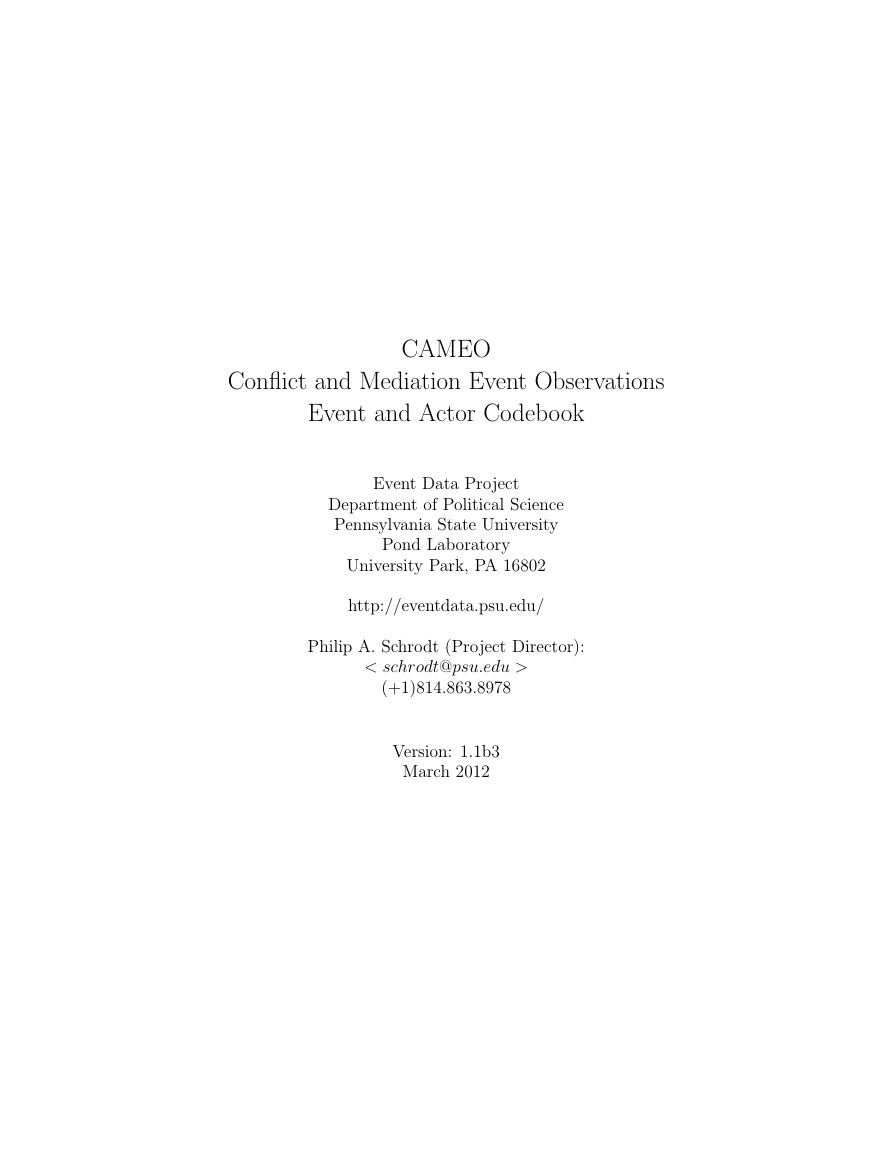
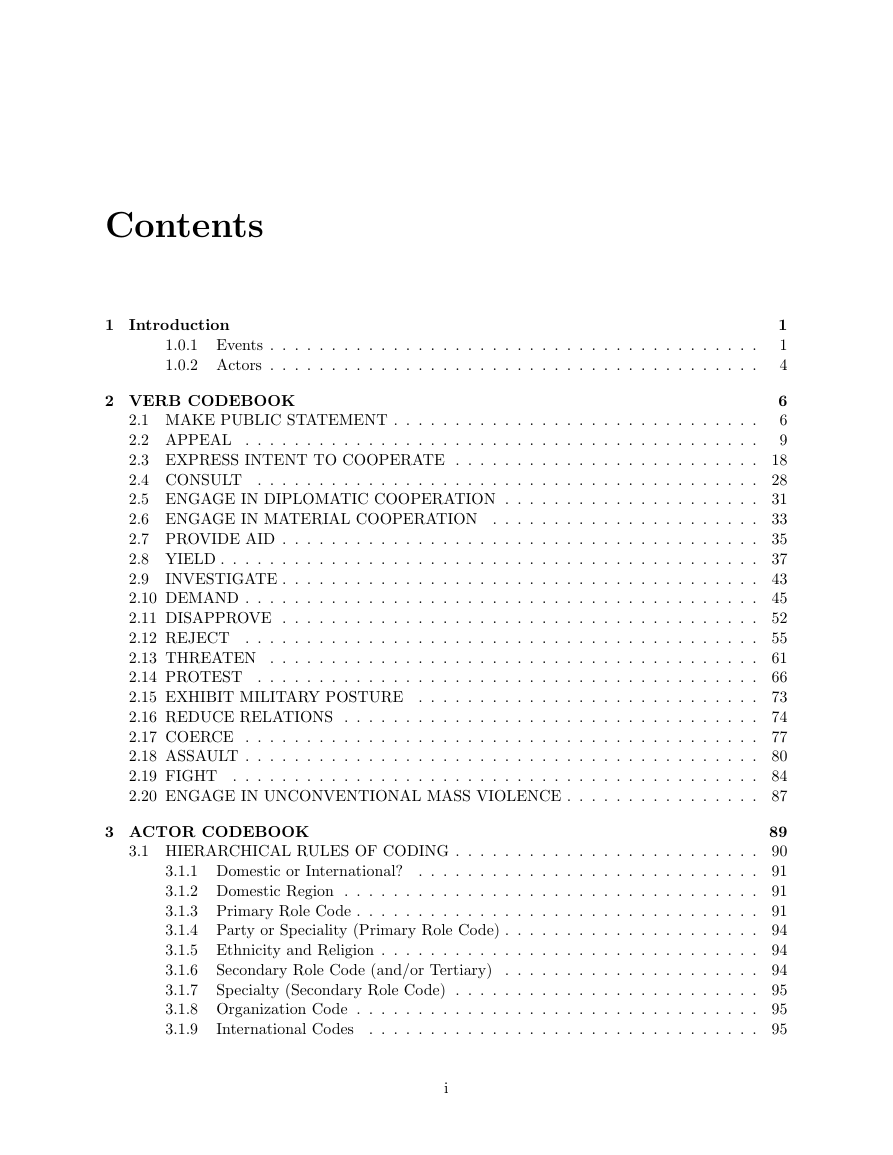
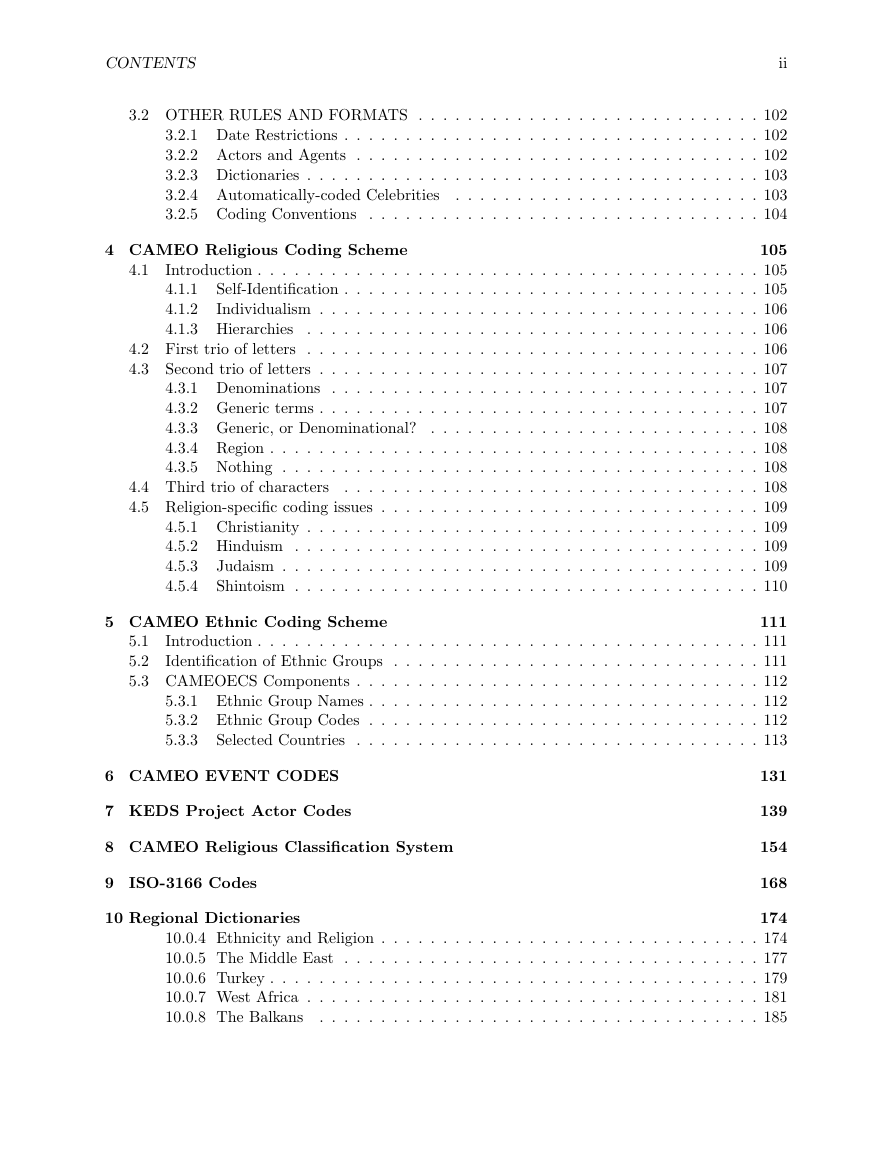
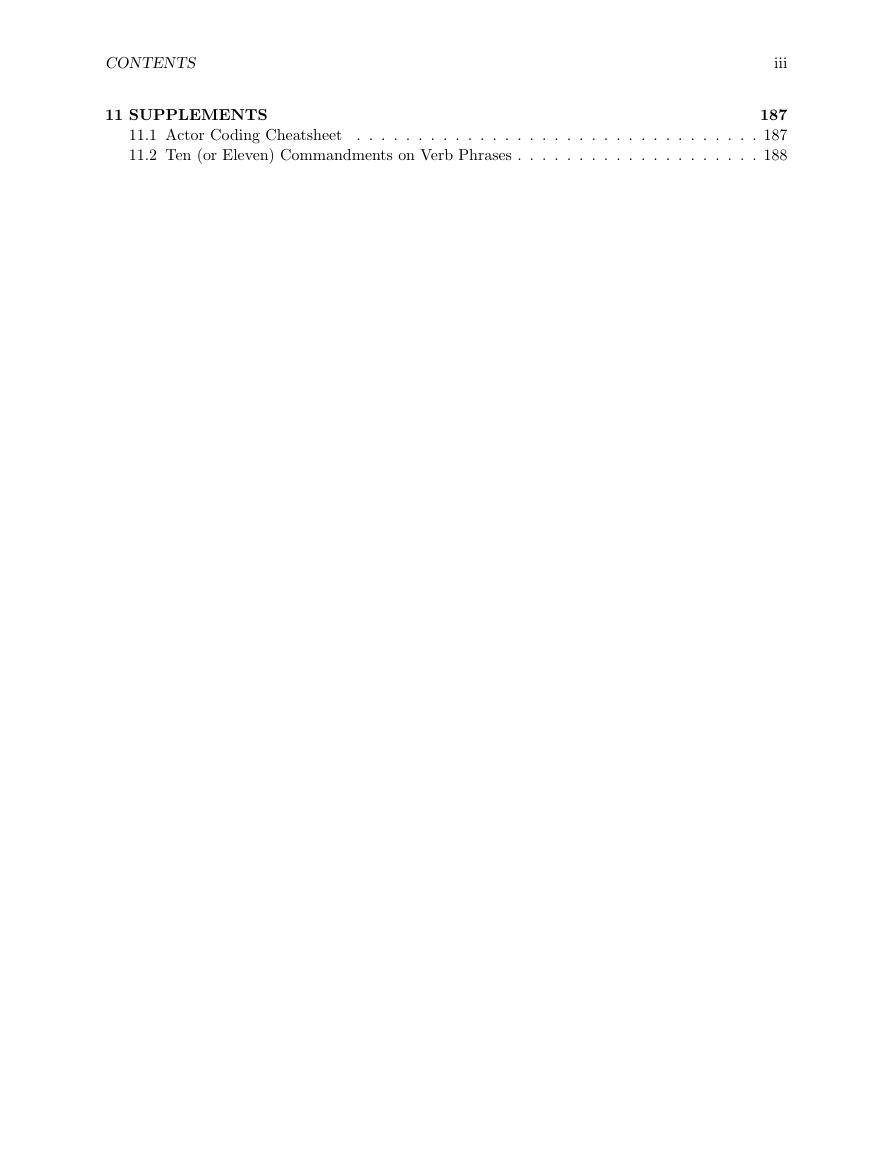
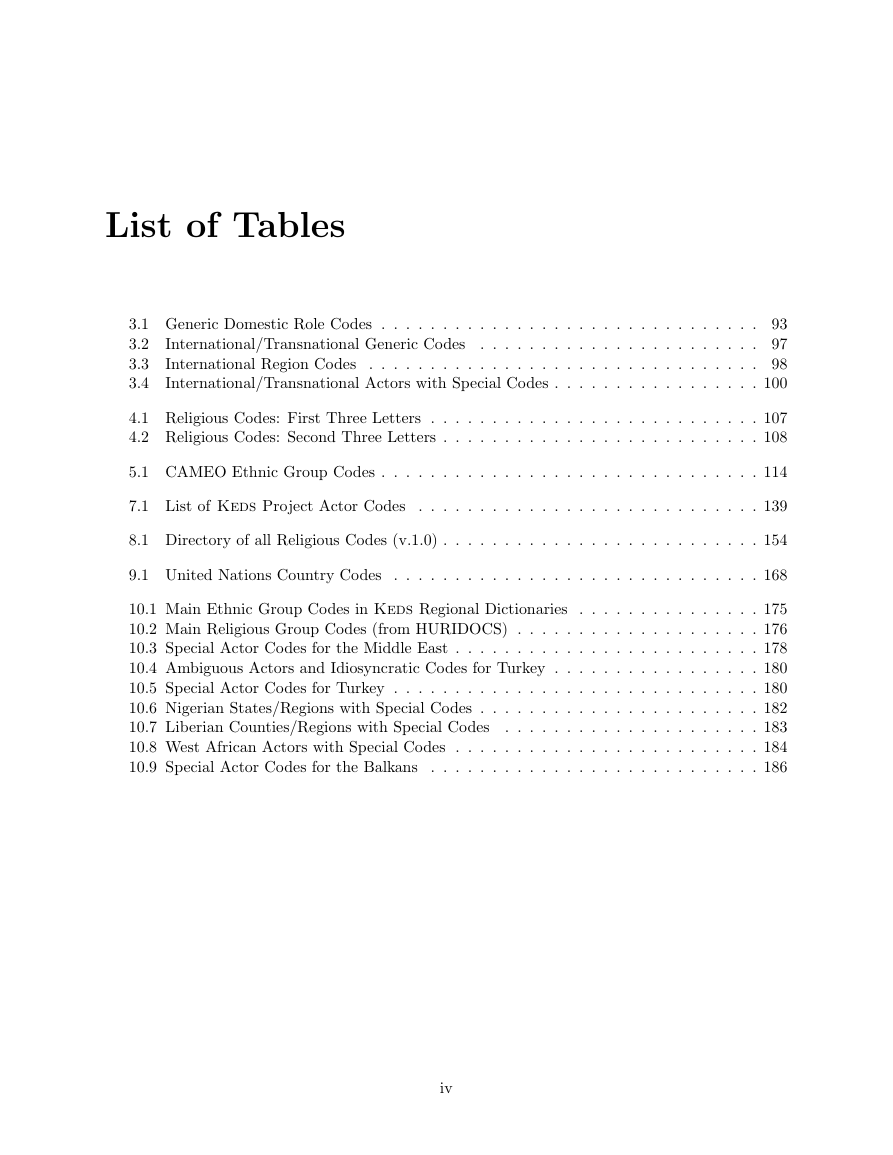
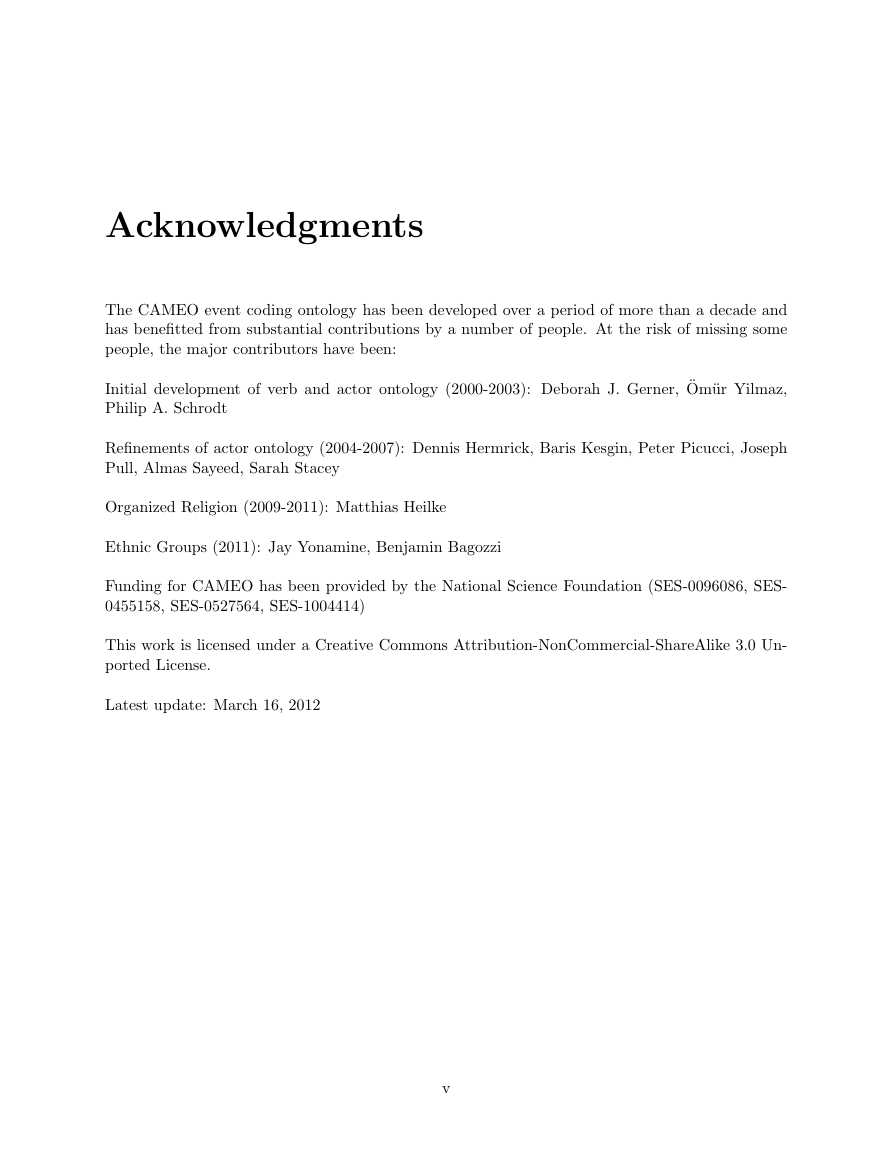
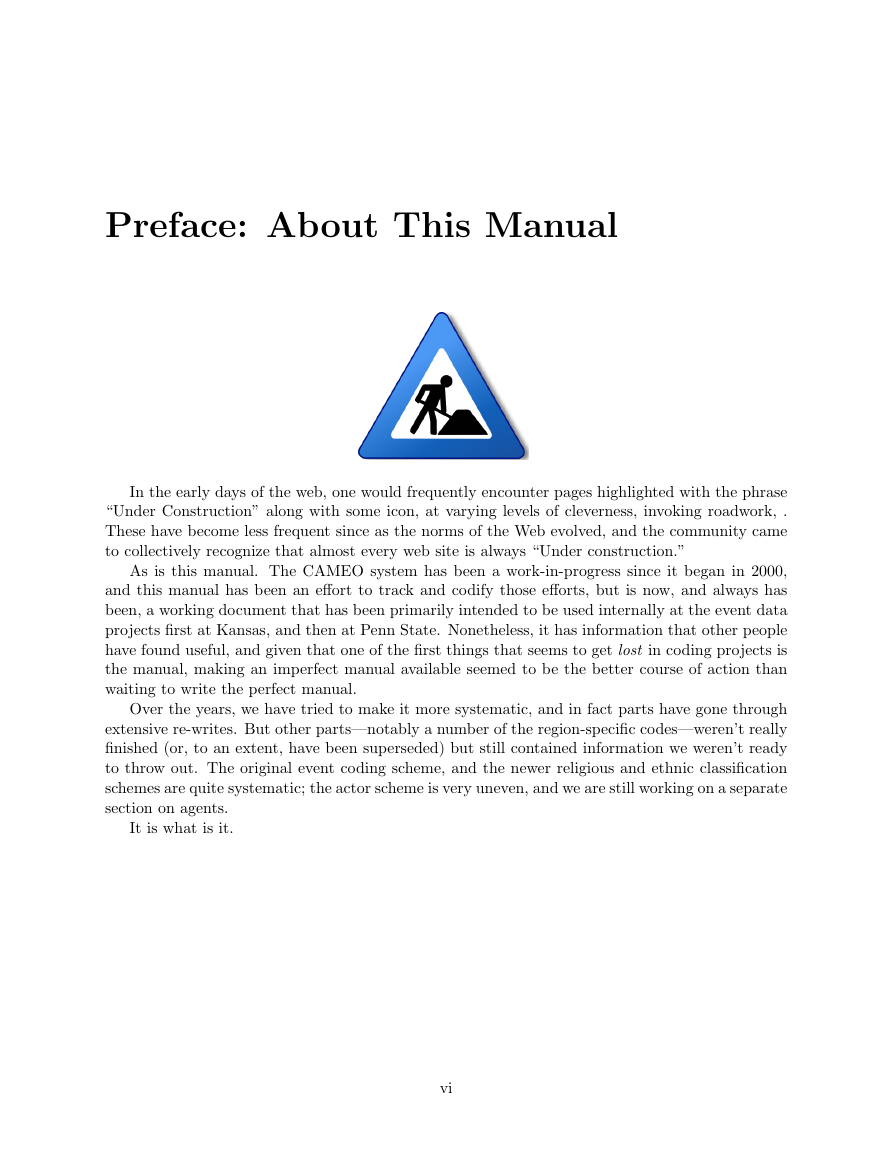
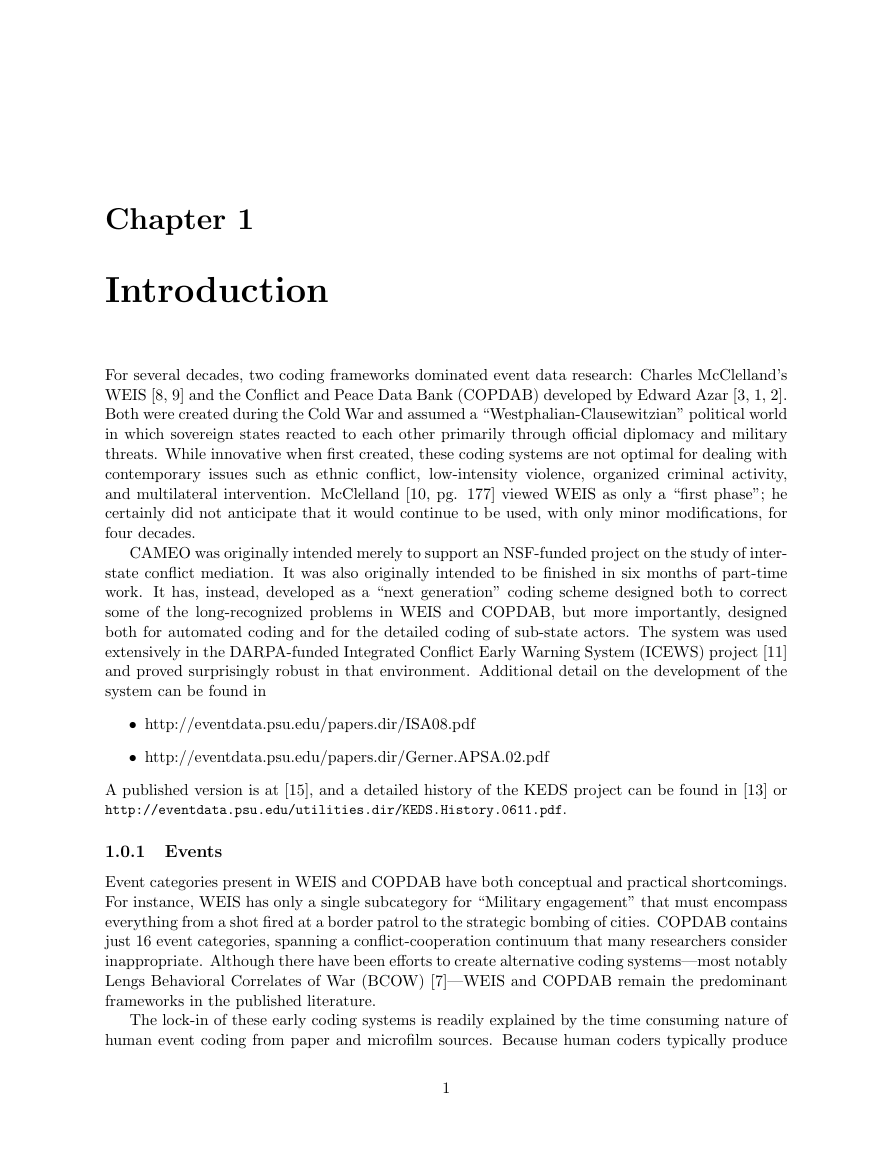








 2023年江西萍乡中考道德与法治真题及答案.doc
2023年江西萍乡中考道德与法治真题及答案.doc 2012年重庆南川中考生物真题及答案.doc
2012年重庆南川中考生物真题及答案.doc 2013年江西师范大学地理学综合及文艺理论基础考研真题.doc
2013年江西师范大学地理学综合及文艺理论基础考研真题.doc 2020年四川甘孜小升初语文真题及答案I卷.doc
2020年四川甘孜小升初语文真题及答案I卷.doc 2020年注册岩土工程师专业基础考试真题及答案.doc
2020年注册岩土工程师专业基础考试真题及答案.doc 2023-2024学年福建省厦门市九年级上学期数学月考试题及答案.doc
2023-2024学年福建省厦门市九年级上学期数学月考试题及答案.doc 2021-2022学年辽宁省沈阳市大东区九年级上学期语文期末试题及答案.doc
2021-2022学年辽宁省沈阳市大东区九年级上学期语文期末试题及答案.doc 2022-2023学年北京东城区初三第一学期物理期末试卷及答案.doc
2022-2023学年北京东城区初三第一学期物理期末试卷及答案.doc 2018上半年江西教师资格初中地理学科知识与教学能力真题及答案.doc
2018上半年江西教师资格初中地理学科知识与教学能力真题及答案.doc 2012年河北国家公务员申论考试真题及答案-省级.doc
2012年河北国家公务员申论考试真题及答案-省级.doc 2020-2021学年江苏省扬州市江都区邵樊片九年级上学期数学第一次质量检测试题及答案.doc
2020-2021学年江苏省扬州市江都区邵樊片九年级上学期数学第一次质量检测试题及答案.doc 2022下半年黑龙江教师资格证中学综合素质真题及答案.doc
2022下半年黑龙江教师资格证中学综合素质真题及答案.doc